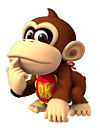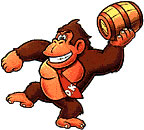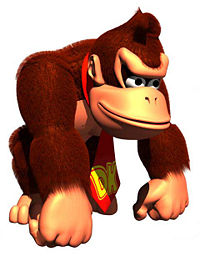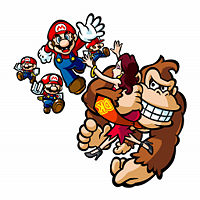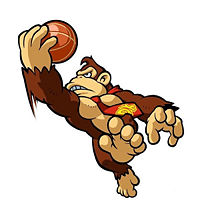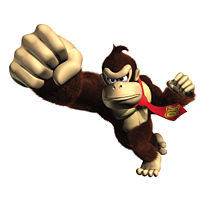Donkey Kong
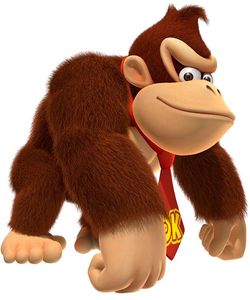
| |
| Donkey Kong in Donkey Kong Country Returns. | |
| Donkey Kong | |
| Species | Kong |
| Eye color | Black |
| Base | Donkey Kong Island |
| Relatives | Cranky Kong (grandfather) Wrinkly Kong (grandmother) |
| Voiced by | Kevin Bayliss (1994-2001) Isaac Marshall (1996) Takahashi Nagasako (2005-Present) |
| Debut | Donkey Kong (Classic DK) Donkey Kong Country (Modern DK) |
Donkey Kong is the name of two different gorillas who are featured as the main characters of the Donkey Kong series. The original Donkey Kong was featured in several arcade games, first and most prominently as Mario's antagonist of the original Donkey Kong game. In the 1990s, Rareware introduced a new Donkey Kong, referred to as the modern Donkey Kong for the sake of disambiguation, who is descended from the arcade Donkey Kong and has acted as the protagonist of various games starting with the Donkey Kong Country series. This Donkey Kong acts as the protector of Donkey Kong Island and its banana horde. He also has his own recurring sidekick, Diddy Kong, and makes regular guest appearances in the sports and party spin-offs of the Mario games. He has also been featured in the Mario vs. Donkey Kong subseries, several games of which have him taking his turn at a light-hearted antagonistic role.
Background[edit]
Baby Donkey Kong[edit]
In Yoshi's Island DS, Baby Donkey Kong was among the many babies kidnapped by Kamek. However, he was freed and joined the Yoshis in their trip to save the other babies. Baby Donkey Kong aided the Yoshis with his great strength and vine-climbing abilities. At the end of the game, he was returned to his home, which was shown to be a jungle hut. He was also revealed to be one of the star children, a baby born with one of the seven fallen stars.
Baby Donkey Kong has also appeared as an unlockable character in Mario Super Sluggers.
It has never been clarified whether this is the infant version of the classic or modern Donkey Kong.
Classic Donkey Kong[edit]
Donkey Kong was first featured in the arcade game of the same name, when he kidnapped Pauline and brought her o a construction site. Mario pursued him through different levels of the construction site, which would later be established to be part of New Donk City and ultimately defeated him by dropping the girders below him to make him fall on his head. In the 1994 Game Boy remake, this only marked the beginning of the battle, as Donkey Kong quickly recovered and snatched Pauline. He led Mario on a chase across a variety of environments while being aided by his son, Donkey Kong Junior. There was a confrontation every fourth level and a boss fight at the end of each world where Mario had to toss Donkey Kong's barrels or certain enemies back at him. The final battle took place atop a tower, where Donkey Kong became a giant (seemingly with the aid of a Super Mushroom), but Mario was still able to beat him. Donkey Kong returned to normal size and was easily pushed around by Mario, who was empowered by a Super Mushroom. This caused the Kongs to make peace with Mario and Pauline, and the four took a photo together.
The roles were later reversed, and Donkey Kong was held captive in a cage by Mario within a jungle environment in Donkey Kong Junior. Junior was able to save Donkey Kong from Mario this time and dropped Mario in the process. The Donkey Kong of this era made only one more appearance as the villain in Donkey Kong 3, where he wreaked havoc within a greenhouse with an army of insects until he was defeated by Stanley the Bugman.
Afterwards, according the the Donkey Kong Country games, the classic Donkey Kong later grew elderly and became the cantankerous old ape known as Cranky Kong. His successor was his grandson, the modern day Donkey Kong.
Modern Donkey Kong[edit]
Donkey Kong Country[edit]
The modern Donkey Kong was featured throughout the Donkey Kong Country series with a more fleshed out character than his classic counterpart. Donkey Kong is shown as an easygoing yet powerful gorilla who enjoys a great deal of music, whether it is on his boombox or playing it on his own bongos. He has a love interest named Candy Kong. His main duty, despite being occasionally lazy towards it, was protected his giant banana horde from his Kremling enemies. His carefree lifestyle made him an easy target for Cranky Kong's criticism.
His own adventures started when his banana horde was threatened by his own nemesis, the kremling leader King K. Rool. He began training Diddy to become a new video game hero and initially treated Diddy harshly, but became more friendly towards him over time. In Donkey Kong Country and Donkey Kong Land, Donkey Kong and Diddy teamed up to stop K. Rool and save his precious banana horde. After beating him for the first time in Donkey Kong Country, Cranky complained that the game was only popular because of the Super NES's fancy graphics. He lured the two young Kongs into betting that they could have a great adventure even on the technically inferior Game Boy, which caused Cranky to call over K. Rool to steal the banana horde again and set into motion the adventure of Donkey Kong Land. They battled K. Rool in several different areas of the island and ultimately thwarted him again.
In Donkey Kong Country 2: Diddy's Kong Quest, Donkey Kong was captured by K. Rool when he was lounging on the beach, and he had to be rescued by Diddy and Dixie. After being freed, the first thing he did was uppercut K. Rool to send him flying out off his aircraft, where he plunged to a presumed demise, but he survived. Donkey Kong, Diddy and Dixie watched the destruction of Crocodile Island victoriously from Donkey Kong Island. However, several months later, Donkey Kong and Diddy were both captured by K. Rool, who used them to power his robot, KAOS. Dixie and Kiddy set out to save them in Donkey Kong Country 3: Dixie Kong's Double Trouble, and ultimately they were both saved. Donkey and Diddy also missed out on the adventure of Donkey Kong Land III when he and Diddy went out looking for the Lost World, but Dixie, Kiddy and K. Rool found it instead.
It was not until Donkey Kong 64 that Donkey Kong was back in action and had to save several other Kongs as well as retrieving his stolen Golden Bananas and preventing K. Rool from annihilating Donkey Kong Island with his new weapon of mass destruction. In this game, he proved his skill by using a Coconut Gun, Bongos, and more. Working alongside Diddy, Tiny, Chunky and Lanky and with the help of various allies, Donkey Kong able to thwart K. Rool's scheme, reclaim his Golden Bananas and relax once more.
Mario and Donkey Kong[edit]
As for Mario, he and Donkey Kong were able to build up a friendship over time despite their shaky beginnings, and he often was a part of Mario's gang for the various sporting events. Despite the kinship between the two, Donkey Kong and Mario had another series of bouts which started in Mario vs. Donkey Kong, when Donkey Kong became obsessed with the Mini-Mario toys and decided to steal a bunch of them for himself by attacking the toy factory. After a great many battles in the vein of Donkey Kong GB, Donkey Kong ran out of Mini-Mario toys and was defeated. Mario still gave him his very own Mini-Mario toy afterwards.
A second tussle ensued in Mario vs. Donkey Kong 2: March of the Minis. This time, Donkey Kong attended the grand opening of Super Mini-Mario World and fell in love with Pauline, who was there to cut the ribbon. He attempted to offer her a Mini-Donkey Kong toy, but Pauline instead grabbed a Mini-Mario toy offered by Mario and rubbed it against her face. Furiously jealous, Donkey Kong kidnapped Pauline and took her to the roof of the Super Mini-Mario World. There, he showered her with presents and tea. Mario eventually found him with the help of the Mini-Mario toys. Donkey Kong reluctantly surrendered, but his spirits were lifted after Pauline kissed the Mini-Donkey Kong toy. Mario, Pauline and Donkey Kong proceed to conduct an orchestra of the various toys. Mario vs. Donkey Kong: Minis March Again! featured an alternate version of the previous game's story. It started the same, with Donkey Kong capturing Pauline and taking her to the top of the tower. However, after the Mini-Marios arrived, Donkey Kong took Pauline away, and the chase continued. When they reached Pauline at the end, it was revealed that the entire kidnapping was faked by Pauline and Donkey Kong in order to test the Mini-Mario toys.
In Mario vs. Donkey Kong: Mini-Land Mayhem!, Donkey Kong rushed to Super Mini-Mario World in order to obtain a Mini-Pauline toy, as free ones were given out to the first hundred customers. However, he arrived there too late and was the one hundred and first customer. Out of anger, he kidnapped Pauline again and led the Mini-Mario's on another chase. The final battle involved firing Mini-Marios at Donkey Kong while he clung to a ferris wheel. After being defeated the first time, he ran off with Pauline again and led Mario on the same chase through more difficult versions of the same levels. After beating him again, Mario was able to placate Donkey Kong by giving him one of the Mini-Pauline toys. Donkey Kong proceeded to gleefully ride the ferris wheel while holding his toy.
Afterwards, the peace between Mario and Donkey Kong managed to last, resulting in Mario and Donkey Kong: Minis on the Move. In that game, Donkey Kong did not appear as an antagonist, and instead he worked with Pauline as a host for the Mini-Land. Donkey Kong returned to being an antagonist and kidnapped Pauline again in Mario vs. Donkey Kong: Tipping Stars, but at the end of the game, it turned out that this was staged in order to lure Mario into a surprise party.
Post-Rareware Adventures[edit]
In Donkey Konga, Donkey Konga 2 and Donkey Konga 3, Donkey Kong and Diddy (later joined by Dixie and Funky in the sequels) formed a career in playing bongo drums. Donkey Kong's next adventure would be Donkey Kong Jungle Beat, where he battled a series of evil apes and other enemies. In DK: King of Swing, he chased K. Rool around the island after the Kremling stole the medals for the upcoming Jungle Jam Tournament and declared himself the jungle hero. Donkey Kong was ultimately able to defeat King K. Rool yet again and reclaimed all of the medals. Next, he helped out Xananab in DK: Jungle Climber after K. Rool stole the alien's supply of the powerful Crystal Bananas. He teamed up with Cranky and Diddy, and together they pursued K. Rool all the way to the planet Plantaen, where K. Rool used the Crystal Banana to become a giant. Despite his more powerful form, King K. Rool was still defeated.
His banana horde was stolen again in Donkey Kong Country Returns, but this time by the Tiki Tak Tribe. With Diddy by his side, he fought his way across the island once again and through the various Tiki minions. At the factory, he was enraged to find that the stolen bananas were being ground up and used to power more and more Tikis. After he made his way through all the Tiki commanders, Donkey Kong and Diddy reached the tower in the volcano where their boss, Tiki Tong, awaited. After an arduous battle, Donkey Kong defeated Tiki Tong and was immediately launched into space. Landing on the moon, Donkey Kong proceeded to punch the moon down to Earth so that it would smash Tiki Tong's tower, as well as Tiki Tong's remains. This caused a volcanic eruption that returned the moon to space and scattered the remaining bananas across the island. Donkey Kong started to fall back to the island, but luckily Diddy Kong was there to save him. It was alternately possible for Diddy Kong to be the one to finish off Tiki Tong and bring down the moon, in which case Donkey Kong showed up to catch him.
In Donkey Kong Country: Tropical Freeze, an attempt to celebrate Donkey Kong's birthday was disrupted when the Snomads attacked the island. Donkey Kong and the others were sent flying to another island by the winds that they caused, which also covered the island in snow and ice. Donkey Kong proceeded to work with Diddy, Dixie and Cranky (as well as Funky in the Switch version's Funky Mode) to work his way through the various islands on the way back to Donkey Kong Island. After arriving at the island, he defeated the leader of the Snowmads, Lord Fredrik, and he used his horn to undo the winter he had brought about. The Kongs celebrated by playing music together, with Donkey Kong playing the horn. After the credits, Donkey Kong discovered one of his displaced birthday presents and opened it to witness something glowing within.
In Dr. Mario World, a medical version of Donkey Kong known as Dr. Donkey Kong became available through the game's Staffing feature starting at the end of October 2019.
In Other Mario/Donkey Kong-Related Games[edit]
Sports, Racing and Party Appearances[edit]
Donkey Kong has made appearances in the following Mario sports games:
- Golf: Donkey Kong was playable in Mario Golf 64 (where he is unlocked by collecting thirty stars in Ring Shot Mode), Mario Golf: Toadstool Tour, Mario Golf: Advance Tour, Mario Golf: World Tour and Mario Golf: Super Rush. He also appeared as an NPC in NES Open Tournament Golf (in which he was depicted wearing clothing) and Mario Golf GBC.
- Kart Racing: Donkey Kong was playable in Mario Kart 64, Mario Kart: Super Circuit, Mario Kart: Double Dash!!, Mario Kart Arcade GP, Mario Kart DS, Mario Kart Arcade GP 2, Mario Kart Wii and Mario Kart 7, Mario Kart Arcade GP DX, Mario Kart 8, Mario Kart 8 Deluxe and Mario Kart Tour (unlocked through the game's gacha feature). In Mario Kart Tour, a variant of Donkey Kong as a gladiator was later made available in certain tours starting with June 2028's Night Tour.
- Tennis: Donkey Kong was playable in Mario Tennis 64, Mario Tennis GBC (through the Nintendo 64 game transfer pak), Mario Power Tennis, Mario Tennis: Power Tour, Mario Tennis Open, Mario Tennis: Ultra Smash and Mario Tennis Aces.
- Baseball: Donkey Kong was a playable captain in Mario Superstar Baseball and Mario Super Sluggers. His team is the DK Wilds.
- In the Challenge Mode of Mario Super Sluggers, Donkey Kong was the captain of the DK Jungle area. He initially attempted to solve the problems of the jungle area himself and constantly left Mario behind, but eventually joined the team to help liberate his ballpark from Bowser Jr.. His special abilities outside of baseball games were breaking crates with his slamming attacks and climbing vines. Baby Donkey Kong was found hidden in a tree in the area and would join the baseball team after being discovered.
- Soccer: Donkey Kong was a playable captain in Super Mario Strikers, Mario Strikers Charged and Mario Strikers: Battle League.
- The Olympics: Donkey Kong is playable in Mario & Sonic at the Olympic Winter Games, Mario & Sonic at the London 2012 Olympic Games and Mario & Sonic at the Sochi 2014 Olympic Winter Games, Mario & Sonic at the Rio 2016 Olympic Games and Mario & Sonic at the Olympic Games Tokyo 2020.
- Other Sports: Donkey Kong was playable in Mario Hoops 3-on-3, Mario Sports Mix and Mario Sports Superstars.
He has also starred in his own racing game, Donkey Kong Barrel Blast, in which his designated rival was a Kritter. By completing all of Candy's Challenges, the player could also unlock a variation of Donkey Kong called Ultra Barrel DK, who raced with special Ultra Barrels.
Mario Party[edit]
Within the Mario Party series, he initially appeared in Mario Party, Mario Party 2, Mario Party 3 and Mario Party 4 as a playable character. Within the Story Mode of Mario Party 3, unless he is the character selected by the player, he will arrive to challenge the player's character to a Duel game for the Strength Star Stamp.
Starting in Mario Party 5, however, Donkey Kong became a nonplayable character who held minigames at his space. He would also punch out Bowser if he ever approached his space. Donkey Kong continued serving this role in Mario Party 6, Mario Party 7, Mario Party 8 and Mario Party 9, and he also had his own board in the latter two games. In the Story Mode of Mario Party DS, he and Diddy received invitations to Bowser's party with the other characters, but he was turned into stone by Dry Bones until he was restored by Mario and the others in the third board of the Story Mode. He then continued to run off in search of free food and accidentally broke Bowser's minimizer later on, restoring the others to normal size. Afterwards, he and Diddy were seen enjoying the food in the ending.
Donkey Kong finally made a return appearance as a playable character in Mario Party 10 and has since been playable in Mario Party: Star Rush, Super Mario Party (where he was unlocked by completing three routes in River Survival mode) and Mario Party Superstars. He also made another non-playable appearance in Mario Party: The Top 100.
Cameos and Non-Storyline Roles[edit]
- The original Donkey Kong was also featured in several Game & Watch games: Donkey Kong, Donkey Kong Jr. and Donkey Kong II were adaptations of the first two arcade games in which Donkey Kong played roles identical to the corresponding games. In the Game & Watch take on Donkey Kong 3, Stanley and Donkey Kong used spray guns to push bees at each other, with Donkey Kong being playable by a second player in Game B. Donkey Kong was also featured in Donkey Kong Circus, where he juggled while Mario watched, as well as Donkey Kong Hockey, in which Mario and Donkey Kong competed in a hockey game, with Donkey Kong being controlled by a second player. These notably were the first games in which Donkey Kong himself was playable. Donkey Kong also made a cameo appearance at the beginning of Mario's Cement Factory, where he made a failed attempt to lob a burning barrel at Mario.
- Mario Clash: An image of Donkey Kong and Donkey Kong Junior would appear to congratulate the player upon reaching 800,000 points.
- Super Mario RPG: Legend of the Seven Stars, Mario & Luigi: Superstar Saga: Both games feature characters that act as homages to Donkey Kong. In the former game, there are the Chained Kong and Guerilla enemies, who resemble Donkey Kong bound by chains. There is also one area in which a Guerilla throws barrels that Mario must jump over in an homage to Donkey Kong. In the latter game, a skeletal gorilla named Bink runs a minigame that utilizes barrels, but his appearance was altered to be human-like in the 3DS remake.
- Game & Watch Gallery 2, Game & Watch Gallery 3, Game & Watch Gallery 4: Donkey Kong was featured in the Classic and Modern versions of the Donkey Kong Game & Watch game in Game & Watch Gallery 2 and 4, as well as appearing in both the Classic and Modern versions of the Donkey Kong Jr. game in Game & Watch Gallery 3. Donkey Kong sports his red tie in the Modern games, and he has Peach held captive instead of Pauline in the Modern versions of Donkey Kong.
- Yoshi's Woolly World: A Yoshi design based on Donkey Kong's appearance could be unlocked by scanning an amiibo of Donkey Kong.
- Super Mario Maker: Donkey Kong was among the different costumes that Mario could turn into upon using the Mystery Mushroom. Donkey Kong's appearance was unlocked by scanning a Donkey Kong amiibo or through completion of a 100 Mario Challenge on normal or harder. Donkey Kong was shown as an 8-bit version of his modern appearance, but with sound effects from the Donkey Kong arcade game.
- Mini Mario & Friends: amiibo Fun: A Mini Donkey Kong toy appears as a playable character that is unlocked by scanning a Donkey Kong amiibo and has the unique ability to traverse slopes.
- Super Mario Odyssey: The city of New Donk City is named in reference to Donkey Kong and is filled with Donkey Kong-related references. The names of the city's streets and establishments are all references to Donkey Kong Country characters, and there is graffiti of Donkey Kong's original arcade appearance on one city wall, as well as a poster for Donkey Kong. Pauline appears as the mayor, and the city is retroactively established as the setting of the original Donkey Kong game
- During the festival celebrating the city's history, Mario can turn 8-bit and go through several areas based on the original arcade game, including an appearance by Donkey Kong's original arcade sprite as the final opponent. In this instance, Donkey Kong is beaten by hitting the ? Blocks that he stands upon. The Donkey Kong sprite makes another appearance in an 8-bit segment of the Darker Side of the Moon and is beaten in the same manner.
- Paper Mario: The Origami King: Mario can obtain an oversized paper mache replica of Donkey Kong's head, known as the Jungle King Mask, at Shogun Studios.
Abilities[edit]
Donkey Kong is naturally known for his great strength and weight, but as a side effect he is often shown to be slow. His special abilities shown in Donkey Kong 64 are:
- Gorilla Grab- With this move, Donkey Kong can grab and pull several levers.
- Baboon Blast- After learning this move, Donkey Kong can be fired from special Donkey Kong pads to special Barrel Cannon areas.
- Strong Kong- After entering special Donkey Kong barrels, Donkey Kong is made temporarily invincible. This move is sustained by Crystal Coconuts.
Additionally in Donkey Kong 64, his personal weapon is the Coconut Gun, and his musical instrument is the bongo drums (which precedes his Donkey Konga career)..
Other Appearances[edit]
Video Games[edit]
- In the NES version of Tetris, Donkey Kong could appear with other Nintendo characters on an ending screen, where he plays a drum. He also made a cameo appearance before the ninth and final track of F-1 Race.
- In Banjo-Tooie, a Donkey Kong doll is seen being played with by Goggles.
- Rare also included references to Donkey Kong in some of their other Nintendo 64 games. In Goldeneye 007, his face could be seen on a mountain seen at the Dam, the game's first level. Perfect Dark also had a cheat called DK Mode which gave the characters proportions similar to Donkey Kong.
- Donkey Kong was featured in Volume 8 of Picross NP, which was based on Donkey Kong Country.
- Donkey Kong appears in Punch-Out!! as a hidden opponent, after previously having made a cameo appearance as an audience member in the arcade game. He only had a chance of appearing as an opponent during the game's last challenge, Mac's Last Stand, in which opponents appeared at random until Mac lost three times.
- He appears as a playable character in the board game-themed crossover games Itadaki Street DS and Fortune Street. In the latter game, Donkey Kong appears as an opponent in single-player mode and as a playable character in multiplayer mode.
- Donkey Kong made a playable guest appearance in Nintendo releases of Skylanders: SuperChargers and Skylanders: Imaginators as Turbo Charge Donkey Kong. He drives the Barrel Blaster and is accompanied by Diddy Kong.
- Donkey Kong was available as a playable skin for Nintendo releases of Minecraft as part of the Super Mario Mash-Up Pack.
- In Mario + Rabbids Kingdom Battle, there was a boss named Rabbid Kong who acts as a Rabbid counterpart of Donkey Kong. Donkey Kong also starred in a DLC quest called Donkey Kong Adventure, where he teamed up with Rabbid Peach and Rabbid Cranky to fight Rabbid Kong.
Super Smash Bros.[edit]
Donkey Kong has been featured as a playable fighter in every game of the Super Smash Bros. series, appearing in Super Smash Bros., Super Smash Bros. Melee, Super Smash Bros. Brawl, Super Smash Bros. for Nintendo 3DS/Wii U and Super Smash Bros. Ultimate. He is a purely physical fighter, and he is among the heaviest and physically strongest of the series' fighters. As of Ultimate, he and Dedede are tied for the third heaviest fighter, behind K. Rool and Bowser.
Abilities[edit]
In the Super Smash Bros. series he has the following special moveset:
- Standard Special Move: Giant Punch- A powerful punch that first must be wound up. After the punch is prepared, Donkey Kong can hold it in for several more moments, but will eventually lose the charged power if it is not used soon.
- Side Special Move: Headbutt- Introduced in Melee. With this attack Donkey Kong slams his head down on the opponent, temporarily rooting them in the ground.
- Up Special Move: Spinning Kong- Donkey Kong spins his arms around like a helicopter rotor. This can be used to clear away nearby enemies as well as to help in preventing Donkey Kong from being knocked out of the ring.
- Down Special Move: Hand Slap- With this move Donkey Kong repeatedly slams down on the ground with his hands. Any character within range will be tossed helplessly into the air from the shock of Donkey Kong's assault, leaving them vulnerable to attack.
- Final Smash: Konga Beat- Introduced in Brawl. Inspired by Donkey Konga (although the use of the bongo drums as a weapon may have come from Donkey Kong 64), DK whips out his bongo drums and plays them; the music creates shockwaves that toss back the other players, and the size of the shockwaves can be increased by pressing the buttons in time with the beat. Donkey Kong is invulnerable during this move.
- Final Smash: Jungle Rush- In Ultimate, this move replaces Konga Beat as Donkey Kong's Final Smash. It simply consists of Donkey Kong unleashing a flurry of punches upon the closest opponent(s), ending with a powerful uppercut
Trophies/Stickers/Spirits[edit]
In Melee, he has three unlockable trophies, while in Brawl, he has two trophies: one normal one and one depicting his Final Smash. He also has five different stickers which show him from Donkey Kong Jungle Beat, Mario Superstar Baseball, Mario Kart DS, Mario vs. Donkey Kong 2: March of the Minis and with Pauline from Donkey Kong. In the 3DS/Wii U games, he has two standard trophies in both versions, while the 3DS version also has a trophy showcasing him with the Barrel Train from Mario Kart, and the Wii U version has a trophy for Donkey Kong's Final Smash. In Ultimate, Donkey Kong has a Fighter Spirit that is unlocked by completing Classic Mode with him. There are also Spirits for "Donkey Kong & Lady" (Donkey Kong with Pauline from Donkey Kong) and "Donkey Kong & Bongos" (with the bongo drums from Donkey Konga).
Brawl: The Subspace Emissary[edit]
Donkey Kong's role in Brawl's Adventure Mode, "The Subspace Emissary", begins when Bowser and his Koopas steal Donkey Kong's banana horde. Donkey Kong and Diddy pursued the Koopas and eventually recovered their bananas. However, at that time Bowser ambushed them with a Dark Cannon. Donkey Kong used a Giant Punch on Diddy to send him flying to safety while he was hit by the cannon's beam and turned into a trophy. The Donkey Kong trophy was then kept on a Smash Skiff that made its way towards the Subspace Bomb Factory. It remained there until Diddy Kong arrived with Captain Falcon and Olimar to save him later on. Donkey Kong was restored and then they all made their way through the Subspace Bomb Factory. When the bomb factory was set to explode, Donkey Kong had to drag the reluctant R.O.B. away, and after a battle with Meta Ridley, they escaped the exploding bomb factory and joined with the main party for the game's final battles against Tabuu.
Ultimate: Classic and Adventure Modes[edit]
In Ultimate, Donkey Kong's personal Classic Mode route is called "Journey to New Donk City". It is themed around following Donkey Kong's journey from the jungle to New Donk City, while battling fighters met along the way. It ends with the last pre-boss battle being against Mario and Luigi, followed by a boss fight against Master Hand (with Crazy Hand on higher difficulties), and both of those battles are fought at different versions of the New Donk City stage. Diddy Kong is the first opponent of this route and afterwards appears as his computer-controlled partner for all of the following battles. A giant Donkey Kong also notably appears as the final boss of Jigglypuff's route, in reference to the giant Donkey Kong who appeared as an opponent in the original Super Smash Bros..
In Adventure Mode, Donkey Kong can be found and awakened in the southwestern forest area.
Canceled Appearances[edit]
- There were two NES games related to the Arcade Donkey Kong that were canceled. One was Return of Donkey Kong, of which almost no details were available aside from it having been planned as a sequel to the arcade games that featured Mario (and possibly a forerunner to Donkey Kong GB), and it was also claimed that Donkey Kong would be playable. The other was Donkey Kong no Ongaku Asobi (Donkey Kong's Fun with Music) which would work as a follow-up to Donkey Kong Jr. Math, but instead featuring the cast of the original Donkey Kong conducting music in Music Quiz and composition mode. In this game, Donkey Kong played guitars while Donkey Kong Jr. played an actual drumset.
- Donkey Kong had several Gamecube/GBA appearances that were canceled after Rare was bought out by Microsoft in 2001: Donkey Kong Coconut Crackers (which would have featured him in a puzzle environment and was retooled into It's Mr. Pants), Diddy Kong Pilot (where Donkey Kong was confirmed as a playable racer; this would be retooled into Banjo-Pilot) and Donkey Kong Racing (a Gamecube game that would have been a racing game using the animal buddies and other creatures from the series as mounts in place of vehicles).
- He was intended to appear as a playable character in the original Mario & Sonic at the Olympic Games but was cut, although his model has been discovered through hacking. He has since been included in its sequels.
Other Media[edit]
- Donkey Kong's first non-game appearance was in the Donkey Kong segments of the old Saturday Supercade' cartoon series. There he was constantly being chased by Mario and Pauline (with Donkey Kong being portrayed as the protagonist this time), and he would often wind up getting into classic cartoon situations and saving Pauline somehow. DK was voiced by legendary comedian Soupy Sales. In the Donkey Kong Junior segment, Junior had hit the road in search of his father.
- Donkey Kong appeared in Captain N: The Game Masters, where he resided in Kongo Land and was a loose cannon, attacking both the good guys and the bad guys. He was also portrayed as being gigantic.
- In the 1990's, he starred in his own French Computer Animated show titled Donkey Kong Country which had one musical sequence per episode and featured Donkey Kong as the destined protector of the Crystal Coconut. As the show's title suggested, it was based on Rareware's games and thus included characters such as Diddy, Cranky, Candy and King K. Rool along with original characters. It lasted for two seasons and became surprisingly popular in Japan. He was voiced by Richard Eastwood in this series.
Trivia[edit]
- The story behind Donkey Kong's name is that Shigeru Miyamoto wanted a name that meant "stubborn ape". He apparently learned about the word "donkey" from an English dictionary, which can be used to refer to stubborn people, while "kong" was commonly used as a term to refer to gorillas in Japan, in reference to Kong Kong.
- Donkey Kong's modern design, which adds the red tie, has commonly been attributed to Rareware and has been used as a way to differentiate between the classic and modern Donkey Kongs. The truth is that the red-tied Donkey Kong was designed by Shigeru Miyamoto for Donkey Kong GB, which features the classic Donkey Kong. Thus, the tie is actually shown to have been worn by both versions of Donkey Kong.
- There have been several references to Donkey Kong within Mario games. For example, in Super Mario RPG: Legend of the Seven Stars there is a chained gorilla enemy known as Chained Kong that bears a striking resemblance to Donkey Kong. There is also a skeleton ape in Mario & Luigi. Both of these instances pay homage to the first level of Donkey Kong by having the Donkey Kong-like character throwing barrels that Mario must jump over. Even Bowser paid homage in Super Mario 3D Land.
- Diddy Kong has also sometimes been referred to as Donkey Kong's nephew, although the instruction manual for Donkey Kong 64 clarifies that Diddy is his "nephew wannabe". Aside from Cranky and Wrinkly, it remains uncertain which (if any) of the Kongs are related to Donkey Kong through blood.
- The first Mario vs. Donkey Kong and Super Smash Bros. Melee both presented Donkey Kong as if the modern and classic Donkey Kongs were the same person, seemingly retconning the idea introduced by the then-recently-departed Rare that the classic Donkey Kong had become Cranky Kong and that the modern Donkey Kong was descended from him. However, both of these games' sequels would later enforce the Rare's idea instead: in the second Mario vs. Donkey Kong, the modern Donkey Kong meets Pauline for the first time, while in Super Smash Bros. Brawl, Solid Snake's Codec conversation about Donkey Kong refers to this Donkey Kong as being the original's grandson, and Donkey Kong's trophy in this game does not list any of the arcade games. This seems to indicate that Nintendo is retaining Rare's canon, although there have otherwise been no direct mentions of Cranky being the original Donkey Kong in later games.
- Although Donkey Kong is mentioned in Donkey Kong Land III's instruction manual story, he is not seen in the actual game. That makes it the only title out of the Country or Land games in which he does not appear at all.
- Within the first Country and Land series, Donkey Kong is notable for only appearing in a playable role in the first installment of each (and Donkey Kong 64 if that is being counted as an extension of those series), despite being the title character. He is kidnapped or otherwise absent in all of the sequels.
| Characters in Donkey Kong series |
|---|
| Donkey Kong · Diddy · Dixie · Kiddy · Chunky · Tiny · Lanky · Funky · Cranky Candy · Swanky · Wrinkly · Enguarde · Rambi · Squawks · Animal Buddies · Xananab Fredrik · K. Rool · Tiki Tong · Wizpig Donkey Kong Jr. · Mario · Pauline · Stanley |
| Characters in Super Mario series |
|---|
| Mario · Luigi · Peach · Toad · Toadette · Yoshi · Bowser · Bowser Jr. · Koopalings Daisy · Donkey Kong · Pauline · Rosalina · Toadsworth · Waluigi · Wario |
| Playable Fighters in the Super Smash Bros. Series |
|---|
| Mario · Donkey Kong · Yoshi · Luigi · Link · Samus · Pikachu · Jigglypuff · Kirby · Fox · Ness · Captain Falcon Peach · Bowser · Dr. Mario · Zelda/Sheik · Young/Toon Link · Ganondorf · Pichu · Mewtwo · Falco · Marth · Roy · Ice Climbers · Mr. Game & Watch Wario · Diddy Kong · Pokémon Trainer <Charizard/Ivysaur/Squirtle> · Lucario · Meta Knight · King Dedede · Wolf · Ike · Pit · Lucas · Pikmin & Olimar · R.O.B. · Solid Snake · Sonic Rosalina & Luma · Bowser Jr. · Greninja · Villager · Lucina · Robin · Palutena · Dark Pit · Little Mac · Shulk · Wii Fit Trainer · Duck Hunt · Mii Fighters · Mega Man · Pac-Man Bayonetta · Cloud · Ryu · Corrin Daisy · K. Rool · Incineroar · Ridley · Dark Samus · Isabelle · Chrom · Inkling · Ken · Simon · Richter Piranha Plant · Joker · Hero · Banjo & Kazooie · Terry Bogard · Byleth · Min Min · Steve · Sephiroth · Pyra/Mythra · Kazuya Mishima · Sora |
